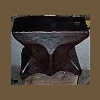-
Posts
274 -
Joined
-
Last visited
Content Type
Profiles
Forums
Articles
Gallery
Downloads
Events
Posts posted by BT
-
-
Hard to tell from your picture, but it looks like the later style of Peter Wright. According to Postman, if it has the word "England" stamped below the word "Patent" it is after 1910.
The Peter Wrights made circa 1885 - 1910 were a little thicker waisted and "squattier" looking and stamped Peter Wright Patent, without the England designation.
Prior to 1885, the faceplate was applied in several pieces, and you can sometimes see the weld lines in the face.
This info is all from Postman. -
-
Here is a pic of the style of gig that I make for the fish giggers around here.
I start with an old four or five prong pitchfork, reshape the tines to about an inch between the tines, cut the tines to length, weld on the barbs and a shaft, roll a socket out of 16 guage sheet and weld. The I harden just the tips of the tines in oil and draw back to a purple. The giggers around here gig in gravel bottom streams, so the points have to be pretty hard to stand up.
BT -
-
Nice find ladysmith. I'm sure you will like the electric blower. I picked up an old Buffalo electric blower 20 years ago or so, and haven't missed my old hand crank blowers a bit :-) .
The stake is a very nice addition to any shop also.
The tongs - I think the first pair (needing adjustment) is for flat iron, like picking up a wagon tire for installation, etc. I have several similar pairs.
The second pair could be used to hold any piece with a head, like a bolt, or like Jr says a socket type tool, or as someone else said, like a railroad spike.
The third pair is probably like Jr said, brazing tongs.
The last pair, I have no clue. Probably not originally designed for blacksmith use, but you never know . . .
But all in all, a very nice find.
BT -
I like to use a length of plumber's solder to trace the full size drawings. It forms and holds the shape easily and then can be restraightened for a measurement.
BT -
-
-
I forgot your other question. You shouldn't need a grate over this. The clinker breaker should keep the coal from falling into the ash dump.
BT -
Stryder
First, I had to figure out where Tunas, Mo is located. :-) You're not all that far from me, but I've never heard of Tunas.
I believe that tuyere is one that was originally designed to be used in a masonry forge with a bellows. The tapered end of a bellows should fit right into the tapered fitting on the tuyere. The firepot would then be formed with fire brick or whatever in the masonry forge.
That being said, there shouldn't be any reason you couldn't adapt it to a fabricated metal forge and build some kind of firepot around it.
At least that is my opinion, I am sure there will be other ideas here.
BT -
Ralph is right. They work much like a Coleman stove. We had one of these when I was a kid. Ours was designed to use gasoline, preferably white gas, but we always used regular gasoline. You would fill the tank, and pressurize it with the built in pump. Ours had a screw on the underside of the burner that you loosened to let raw gas drip into the pan under the burner. When the pan was almost full, you closed the screw and set the pan on fire. When the gas in the pan was almost completely burned you would open the burner valve. The burner assembly would be then be hot enough to vaporize the gasoline coming through the burner.
BT -
Here in the Ozarks, we still have the remnants of the charcoal making industry. The kilns in this area look like concrete Quonset huts with large steel doors on the end. Several truck loads of cordwood, mostly oak and hickory, are loaded into the kiln and set on fire. The doors are closed and sealed with mud. There is a small vent in the top of the kiln to let the gas escape. The fire will burn for several days and take several days to cool. Several years ago, during a particularly dry summer, a trucker was hauling a load of fresh charcoal from a kiln to a briquet factory. The load hadn't completely cooled yet. When the trucker took off, the load caught fire, spewing burning charcoal and starting fires along a 10 mile stretch of country backroads.
BT


how to clean a old drill?
in Drills, Post drills, Mag drills, etc
Posted
I have used Easy Off oven cleaner on some stuff that had layers of caked on grease and dirt. Spray it on and let sit for a while. Then use a power washer on it. Before I had my own power washer, I used to load stuff on the back of the pickup and head for the nearest car wash.
NOTE: observe safety precautions when using the Easy Off. Read the caution on the can.